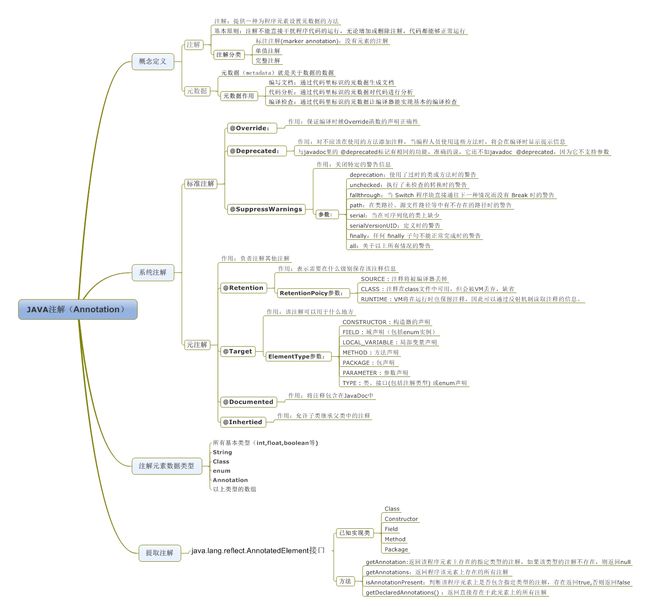元注解:
元注解的作用就是负责注解其他注解。Java5.0定义了4个标准的meta-annotation类型,它们被用来提供对其它 annotation类型作说明。Java5.0定义的元注解:
1.@Target,
2.@Retention,
3.@Documented,
4.@Inherited
这些类型和它们所支持的类在java.lang.annotation包中可以找到。下面我们看一下每个元注解的作用和相应分参数的使用说明。
@Target:
@Target说明了Annotation所修饰的对象范围:Annotation可被用于 packages、types(类、接口、枚举、Annotation类型)、类型成员(方法、构造方法、成员变量、枚举值)、方法参数和本地变量(如循环变量、catch参数)。在Annotation类型的声明中使用了target可更加明晰其修饰的目标。
作用:用于描述注解的使用范围(即:被描述的注解可以用在什么地方)
取值(ElementType)有:
1.CONSTRUCTOR:用于描述构造器
2.FIELD:用于描述域
3.LOCAL_VARIABLE:用于描述局部变量
4.METHOD:用于描述方法
5.PACKAGE:用于描述包
6.PARAMETER:用于描述参数
7.TYPE:用于描述类、接口(包括注解类型) 或enum声明
使用实例:
@Target(ElementType.TYPE)
public @interface Table {
/**
* 数据表名称注解,默认值为类名称
* @return
*/
public String tableName() default "className";
}
@Target(ElementType.FIELD)
public @interface NoDBColumn {
}
注解Table 可以用于注解类、接口(包括注解类型) 或enum声明,而注解NoDBColumn仅可用于注解类的成员变量。
@Retention:
@Retention定义了该Annotation被保留的时间长短:某些Annotation仅出现在源代码中,而被编译器丢弃;而另一些却被编译在class文件中;编译在class文件中的Annotation可能会被虚拟机忽略,而另一些在class被装载时将被读取(请注意并不影响class的执行,因为Annotation与class在使用上是被分离的)。使用这个meta-Annotation可以对 Annotation的“生命周期”限制。
作用:表示需要在什么级别保存该注释信息,用于描述注解的生命周期(即:被描述的注解在什么范围内有效)
取值(RetentionPoicy)有:
1.SOURCE:在源文件中有效(即源文件保留)
2.CLASS:在class文件中有效(即class保留)
3.RUNTIME:在运行时有效(即运行时保留)
Retention meta-annotation类型有唯一的value作为成员,它的取值来自java.lang.annotation.RetentionPolicy的枚举类型值。具体实例如下:
@Target(ElementType.FIELD)
@Retention(RetentionPolicy.RUNTIME)
public @interface Column {
public String name() default "fieldName";
public String setFuncName() default "setField";
public String getFuncName() default "getField";
public boolean defaultDBValue() default false;
}
Column注解的的RetentionPolicy的属性值是RUTIME,这样注解处理器可以通过反射,获取到该注解的属性值,从而去做一些运行时的逻辑处理
@Documented:
@****Documented用于描述其它类型的annotation应该被作为被标注的程序成员的公共API,因此可以被例如javadoc此类的工具文档化。Documented是一个标记注解,没有成员。
@Target(ElementType.FIELD)
@Retention(RetentionPolicy.RUNTIME)
@Documented
public @interface Column {
public String name() default "fieldName";
public String setFuncName() default "setField";
public String getFuncName() default "getField";
public boolean defaultDBValue() default false;
}
@Inherited:
@Inherited 元注解是一个标记注解,@Inherited阐述了某个被标注的类型是被继承的。如果一个使用了@Inherited修饰的annotation类型被用于一个class,则这个annotation将被用于该class的子类。
注意:@Inherited annotation类型是被标注过的class的子类所继承。类并不从它所实现的接口继承annotation,方法并不从它所重载的方法继承annotation。
当@Inherited annotation类型标注的annotation的Retention是RetentionPolicy.RUNTIME,则反射API增强了这种继承性。如果我们使用java.lang.reflect去查询一个@Inherited annotation类型的annotation时,反射代码检查将展开工作:检查class和其父类,直到发现指定的annotation类型被发现,或者到达类继承结构的顶层。
实例代码:
/**
*
* @author peida
*
*/
@Inherited
public @interface Greeting {
public enum FontColor{ BULE,RED,GREEN};
String name();
FontColor fontColor() default FontColor.GREEN;
}
自定义注解:
使用@interface自定义注解时,自动继承了java.lang.annotation.Annotation接口,由编译程序自动完成其他细节。在定义注解时,不能继承其他的注解或接口。@interface用来声明一个注解,其中的每一个方法实际上是声明了一个配置参数。方法的名称就是参数的名称,返回值类型就是参数的类型(返回值类型只能是基本类型、Class、String、enum)。可以通过default来声明参数的默认值。
定义注解格式:
public @interface 注解名 {定义体}
注解参数的可支持数据类型:
1.所有基本数据类型(int,float,boolean,byte,double,char,long,short)
2.String类型
3.Class类型
4.enum类型
5.Annotation类型
6.以上所有类型的数组
Annotation类型里面的参数该怎么设定:
第一,只能用public或默认(default)这两个访问权修饰.例如,String value();这里把方法设为defaul默认类型;
第二,参数成员只能用基本类型byte,short,char,int,long,float,double,boolean八种基本数据类型和 String,Enum,Class,annotations等数据类型,以及这一些类型的数组.例如,String value();这里的参数成员就为String;
第三,如果只有一个参数成员,最好把参数名称设为"value",后加小括号.例:下面的例子FruitName注解就只有一个参数成员。
简单的自定义注解和使用注解实例:
package annotation;
import java.lang.annotation.Documented;
import java.lang.annotation.ElementType;
import java.lang.annotation.Retention;
import java.lang.annotation.RetentionPolicy;
import java.lang.annotation.Target;
/**
* 水果名称注解
* @author peida
*
*/
@Target(ElementType.FIELD)
@Retention(RetentionPolicy.RUNTIME)
@Documented
public @interface FruitName {
String value() default "";
}
package annotation;
import java.lang.annotation.Documented;
import java.lang.annotation.ElementType;
import java.lang.annotation.Retention;
import java.lang.annotation.RetentionPolicy;
import java.lang.annotation.Target;
/**
* 水果颜色注解
* @author peida
*
*/
@Target(ElementType.FIELD)
@Retention(RetentionPolicy.RUNTIME)
@Documented
public @interface FruitColor {
/**
* 颜色枚举
* @author peida
*
*/
public enum Color{ BULE,RED,GREEN};
/**
* 颜色属性
* @return
*/
Color fruitColor() default Color.GREEN;
}
package annotation;
import java.lang.annotation.Documented;
import java.lang.annotation.ElementType;
import java.lang.annotation.Retention;
import java.lang.annotation.RetentionPolicy;
import java.lang.annotation.Target;
/**
* 水果颜色注解
* @author peida
*
*/
@Target(ElementType.FIELD)
@Retention(RetentionPolicy.RUNTIME)
@Documented
public @interface FruitColor {
/**
* 颜色枚举
* @author peida
*
*/
public enum Color{ BULE,RED,GREEN};
/**
* 颜色属性
* @return
*/
Color fruitColor() default Color.GREEN;
}
package annotation;
import annotation.FruitColor.Color;
public class Apple {
@FruitName("Apple")
private String appleName;
@FruitColor(fruitColor=Color.RED)
private String appleColor;
public void setAppleColor(String appleColor) {
this.appleColor = appleColor;
}
public String getAppleColor() {
return appleColor;
}
public void setAppleName(String appleName) {
this.appleName = appleName;
}
public String getAppleName() {
return appleName;
}
public void displayName(){
System.out.println("水果的名字是:苹果");
}
}
注解元素的默认值:
注解元素必须有确定的值,要么在定义注解的默认值中指定,要么在使用注解时指定,非基本类型的注解元素的值不可为null。因此, 使用空字符串或0作为默认值是一种常用的做法。这个约束使得处理器很难表现一个元素的存在或缺失的状态,因为每个注解的声明中,所有元素都存在,并且都具有相应的值,为了绕开这个约束,我们只能定义一些特殊的值,例如空字符串或者负数,一次表示某个元素不存在,在定义注解时,这已经成为一个习惯用法。例如:
package annotation;
import java.lang.annotation.Documented;
import java.lang.annotation.ElementType;
import java.lang.annotation.Retention;
import java.lang.annotation.RetentionPolicy;
import java.lang.annotation.Target;
/**
* 水果供应者注解
* @author peida
*
*/
@Target(ElementType.FIELD)
@Retention(RetentionPolicy.RUNTIME)
@Documented
public @interface FruitProvider {
/**
* 供应商编号
* @return
*/
public int id() default -1;
/**
* 供应商名称
* @return
*/
public String name() default "";
/**
* 供应商地址
* @return
*/
public String address() default "";
}
注解处理器类库(java.lang.reflect.AnnotatedElement):
Java使用Annotation接口来代表程序元素前面的注解,该接口是所有Annotation类型的父接口。除此之外,Java在java.lang.reflect 包下新增了AnnotatedElement接口,该接口代表程序中可以接受注解的程序元素,该接口主要有如下几个实现类:
Class:类定义
Constructor:构造器定义
Field:累的成员变量定义
Method:类的方法定义
Package:类的包定义
java.lang.reflect 包下主要包含一些实现反射功能的工具类,实际上,java.lang.reflect 包所有提供的反射API扩充了读取运行时Annotation信息的能力。当一个Annotation类型被定义为运行时的Annotation后,该注解才能是运行时可见,当class文件被装载时被保存在class文件中的Annotation才会被虚拟机读取。
AnnotatedElement 接口是所有程序元素(Class、Method和Constructor)的父接口,所以程序通过反射获取了某个类的AnnotatedElement对象之后,程序就可以调用该对象的如下四个个方法来访问Annotation信息:
方法1:
方法2:Annotation[] getAnnotations():返回该程序元素上存在的所有注解。
方法3:boolean is AnnotationPresent(Class annotationClass):判断该程序元素上是否包含指定类型的注解,存在则返回true,否则返回false.
方法4:Annotation[] getDeclaredAnnotations():返回直接存在于此元素上的所有注释。与此接口中的其他方法不同,该方法将忽略继承的注释。(如果没有注释直接存在于此元素上,则返回长度为零的一个数组。)该方法的调用者可以随意修改返回的数组;这不会对其他调用者返回的数组产生任何影响。
一个简单的注解处理器:
/***********注解声明***************/
/**
* 水果名称注解
* @author peida
*
*/
@Target(ElementType.FIELD)
@Retention(RetentionPolicy.RUNTIME)
@Documented
public @interface FruitName {
String value() default "";
}
/**
* 水果颜色注解
* @author peida
*
*/
@Target(ElementType.FIELD)
@Retention(RetentionPolicy.RUNTIME)
@Documented
public @interface FruitColor {
/**
* 颜色枚举
* @author peida
*
*/
public enum Color{ BULE,RED,GREEN};
/**
* 颜色属性
* @return
*/
Color fruitColor() default Color.GREEN;
}
/**
* 水果供应者注解
* @author peida
*
*/
@Target(ElementType.FIELD)
@Retention(RetentionPolicy.RUNTIME)
@Documented
public @interface FruitProvider {
/**
* 供应商编号
* @return
*/
public int id() default -1;
/**
* 供应商名称
* @return
*/
public String name() default "";
/**
* 供应商地址
* @return
*/
public String address() default "";
}
/***********注解使用***************/
public class Apple {
@FruitName("Apple")
private String appleName;
@FruitColor(fruitColor=Color.RED)
private String appleColor;
@FruitProvider(id=1,name="陕西红富士集团",address="陕西省西安市延安路89号红富士大厦")
private String appleProvider;
public void setAppleColor(String appleColor) {
this.appleColor = appleColor;
}
public String getAppleColor() {
return appleColor;
}
public void setAppleName(String appleName) {
this.appleName = appleName;
}
public String getAppleName() {
return appleName;
}
public void setAppleProvider(String appleProvider) {
this.appleProvider = appleProvider;
}
public String getAppleProvider() {
return appleProvider;
}
public void displayName(){
System.out.println("水果的名字是:苹果");
}
}
/***********注解处理器***************/
public class FruitInfoUtil {
public static void getFruitInfo(Class clazz){
String strFruitName=" 水果名称:";
String strFruitColor=" 水果颜色:";
String strFruitProvicer="供应商信息:";
Field[] fields = clazz.getDeclaredFields();
for(Field field :fields){
if(field.isAnnotationPresent(FruitName.class)){
FruitName fruitName = (FruitName) field.getAnnotation(FruitName.class);
strFruitName=strFruitName+fruitName.value();
System.out.println(strFruitName);
}
else if(field.isAnnotationPresent(FruitColor.class)){
FruitColor fruitColor= (FruitColor) field.getAnnotation(FruitColor.class);
strFruitColor=strFruitColor+fruitColor.fruitColor().toString();
System.out.println(strFruitColor);
}
else if(field.isAnnotationPresent(FruitProvider.class)){
FruitProvider fruitProvider= (FruitProvider) field.getAnnotation(FruitProvider.class);
strFruitProvicer=" 供应商编号:"+fruitProvider.id()+" 供应商名称:"+fruitProvider.name()+" 供应商地址:"+fruitProvider.address();
System.out.println(strFruitProvicer);
}
}
}
}
/***********输出结果***************/
public class FruitRun {
/**
* @param args
*/
public static void main(String[] args) {
FruitInfoUtil.getFruitInfo(Apple.class);
}
}
====================================
水果名称:Apple
水果颜色:RED
供应商编号:1 供应商名称:陕西红富士集团 供应商地址:陕西省西安市延安路89号红富士大厦
Java注解的基础知识点(见下面导图)基本都过了一遍,下一篇我们通过设计一个基于注解的简单的ORM框架,来综合应用和进一步加深对注解的各个知识点的理解和运用。
